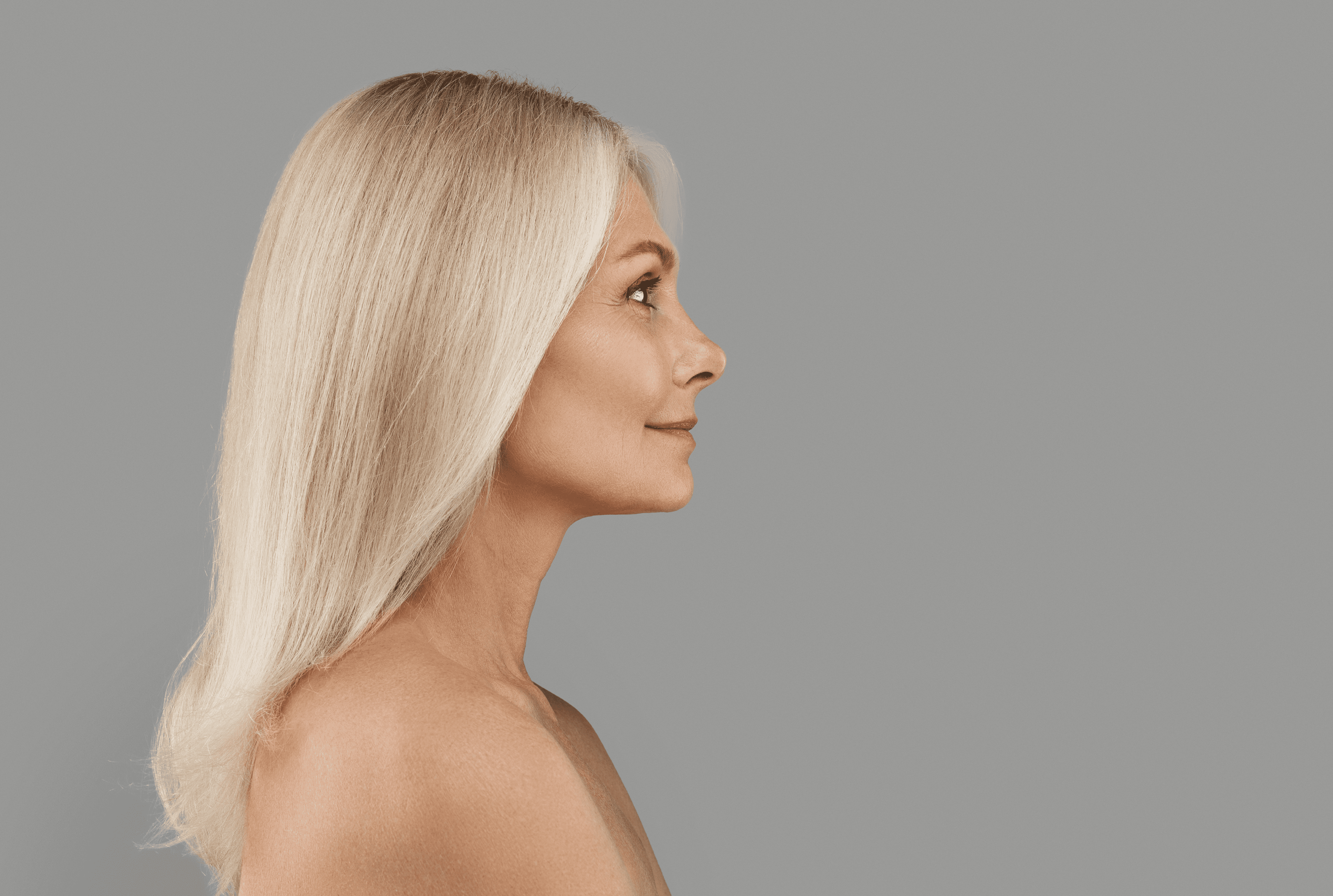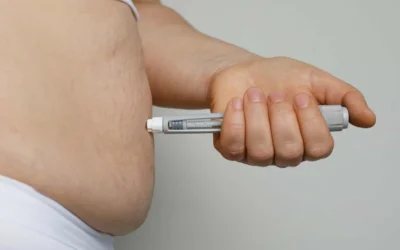Thinning hair during midlife isn’t just a cosmetic issue. It’s a clinical sign of deeper hormonal, metabolic, or nutritional changes. Whether you’re noticing a widening part, more shedding in the shower, or loss of volume, it’s time to stop guessing and start understanding the root cause. This comprehensive guide walks you through the types of hair loss common during menopause, the latest research on GLP-1 medications and hair shedding, and evidence-based treatments that work.
Types of Hair Loss in Midlife Women
Identifying your specific type of hair loss is the first step in choosing the right treatment.
1. Androgenetic Alopecia (Female Pattern Hair Loss)
- Pattern: Thinning at the crown and temples with intact frontal hairline
- Cause: Genetic sensitivity to DHT (dihydrotestosterone) worsened by declining estrogen
- Best Treatments: Minoxidil, anti-androgens like spironolactone, DHT blockers, HRT
2. Telogen Effluvium
- Pattern: Sudden diffuse shedding
- Cause: Triggered by stress, illness, weight loss, thyroid shifts, or stopping HRT
- Best Treatments: Nutritional support, trigger identification, stress reduction
3. Traction Alopecia
- Pattern: Hair loss around edges or where hair is pulled tightly
- Cause: Chronic mechanical tension (tight buns, ponytails, extensions)
- Best Treatments: Discontinue styling habits; early detection improves reversibility
4. Alopecia Areata
- Pattern: Smooth, round bald patches
- Cause: Autoimmune
- Best Treatments: Corticosteroid injections, immune-modulating medications
Why Menopause Triggers Hair Loss
Hormones play a central role in the hair growth cycle. Estrogen and progesterone prolong the anagen (growth) phase. When these levels drop, more hair enters telogen (shedding). Simultaneously, androgens like DHT miniaturize hair follicles, resulting in finer, weaker hair.
Other contributors:
- Thyroid dysfunction
- Low ferritin (iron storage)
- Chronic stress and cortisol imbalance
- Vitamin D, zinc, or biotin deficiency
- Insulin resistance and inflammation
NEW: GLP-1 Medications and Hair Loss
What Are GLP-1s?
Semaglutide (Ozempic, Wegovy) and tirzepatide (Mounjaro) are medications originally developed for type 2 diabetes but now widely used for weight loss. As more people use these powerful tools, reports of hair loss have surfaced.
Is It the Drug or the Weight Loss?
According to recent studies and dermatology reports, most hair loss associated with GLP-1s is due to telogen effluvium, triggered by:
- Rapid weight loss
- Caloric or protein deficiency
- Metabolic stress
In rare cases, autoimmune alopecia areata has been observed.
Quick Fact: A 2025 study published in the Journal of the American Academy of Dermatology found semaglutide users had a 50% higher risk of hair loss diagnosis, especially among women.
How to Prevent Hair Loss on GLP-1s
- Aim for gradual weight loss (1–2 lbs/week)
- Consume 75–100g of protein daily
- Monitor ferritin, vitamin D, zinc, and thyroid labs
- Consider adding Nutrafol Women or Viviscal Pro
- Use topical minoxidil if shedding continues beyond 3 months
Evidence-Based Hair Loss Treatments: What Works
|
Treatment |
Best For |
Pros |
Cons |
|---|---|---|---|
|
Minoxidil |
Female pattern loss |
FDA-approved, stimulates growth |
Must be used long-term, initial shedding, skin irritation |
|
Hormone Replacement Therapy |
Menopausal thinning |
Targets root cause, improves skin and mood too |
Not direct treatment for hair, not for everyone |
|
Spironolactone |
Androgen-driven loss |
DHT blocker, helps acne too |
Not for women TTC, needs monitoring |
|
Supplements (Nutrafol, Viviscal) |
Nutritional or stress-related loss |
Evidence-based, few side effects |
Results take 3+ months, cost |
|
Topical Serums (Vegamour, Act+Acre) |
Mild thinning, support |
Easy to use, pleasant |
Variable results, less clinical evidence |
Recommended Supplements
- Nutrafol Women: Targets DHT, stress, and nutrient gaps; shown to increase hair count in 6 months
- Viviscal Pro: Marine protein, biotin, and zinc support
- Iron: Use only if ferritin <40 ng/mL; try Thorne Iron Bisglycinate
- Vitamin D & Zinc: Essential for follicle health
Lifestyle Strategies for Stronger Hair
1. Eat for Hair Health
- Protein: 20–30g per meal
- Omega-3s: Salmon, chia, walnuts
- Micronutrients: Leafy greens, eggs, pumpkin seeds
2. Reduce Inflammation
- Avoid ultra-processed foods and excess sugar
- Prioritize fiber and antioxidant-rich vegetables
3. Stress Management
- Cortisol spikes increase telogen shedding
- Try breathwork, mindfulness, therapy
4. Sleep & Movement
- Sleep restores follicle cycles
- Exercise boosts circulation and hormone
When to See a Provider
If your hair loss:
- Persists longer than 6 months
- Includes bald patches
- Is accompanied by fatigue, weight gain, or other symptoms
- Started shortly after a medication change
It’s time to evaluate your hormones, thyroid, and nutrient status with a trained provider.
Final Takeaway
Hair loss during menopause or while using GLP-1 medications is real, valid, and often reversible. But there’s no one-size-fits-all fix. Understanding the type of hair loss, the root cause, and the right combination of strategies is where real healing begins.
✅ Ready for Personalized Help?
At Aspect Wellness, we specialize in evidence-based solutions for midlife women, including hormone optimization, weight loss support, and hair restoration therapies. Book a consultation today to take the first step toward your healthiest, most confident self.
Tags: #HairLoss #Menopause #GLP1 #Minoxidil #Nutrafol #MidlifeWellness #HormoneHealth #EvidenceBasedCare

